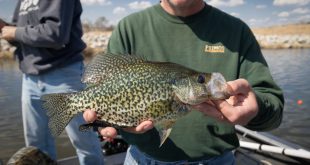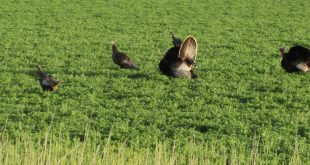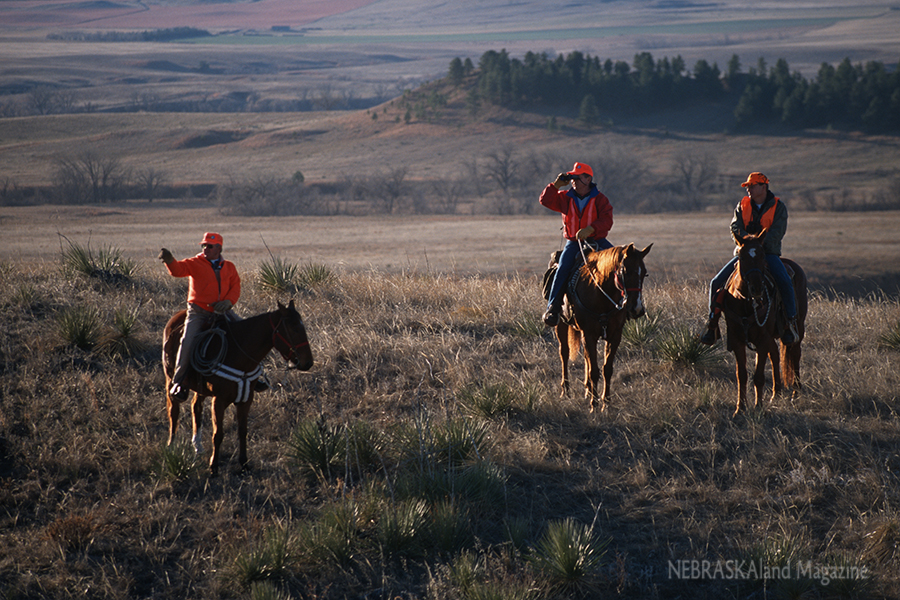
CRAWFORD, Neb. – When tourists catch sight of a bighorn sheep in the Pine Ridge, or a herd of bison grazing at Fort Robinson State Park, they likely give little thought to the people responsible for those animals being there.

One such person is Lon Lemmon, a life-long resident of the Crawford area who was at the forefront of many projects resulting in the wild animals and lands people enjoy today during his 39-year career with the Nebraska Game and Parks Commission.
Lemmon, who retired in 2005, and his wife Carolyn are recent recipients of the Distinguished Service Award from Nebraska’s chapter of The Wildlife Society, an international organization with more than 10,000 conservationists, scientists, educators and students.
“Lon and Carolyn are institutions in northwest Nebraska and deserve a lot of credit for all they have accomplished to further the cause of the region’s wildlife and public lands,” said Greg Schenbeck, the Game and Parks biologist who now handles many of Lon’s former duties. “I’m happy to see them get some recognition for all they have done.”
Lon was not seeking to build a career in wildlife management when it began in the mid-1960s. Rather, it came to him during a period that was a bit uncertain.
His career with Game and Parks began when the land on which he and Carolyn were living was offered for sale to the Commission, later to become Ponderosa Wildlife Management Area. The property, in the scenic Pine Ridge southeast of Crawford, had been owned by James Ivins, a banker in Crawford and Harrison and a long-time business partner of Lemmon’s family. Unfortunately, Ivins was diagnosed with terminal cancer, prompting sale of the land and the end of a partnership that spanned five decades.
When Gary Schlichtemeier of Alliance, who was the Commission’s wildlife manager in the northwest district at that time, was looking for someone to provide day-to-day maintenance on the new property and other wildlife management areas in the Pine Ridge, he approached Lon.
“Gary needed someone to fix fence, tear out fence, and go over to Metcalf, Petersen or Gilbert-Baker (other wildlife management areas in the Pine Ridge) and fix fence there,” Lon said.
The two came to an agreement and Schlichtemeier forwarded the hiring to the agency’s Lincoln headquarters for approval. Lon was set to begin his duties Jan. 1, 1966, but would have to wait. Mel Steen, the Commission’s director at the time, was out of the office to promote the agency so Lemmon’s hiring was delayed a full month.
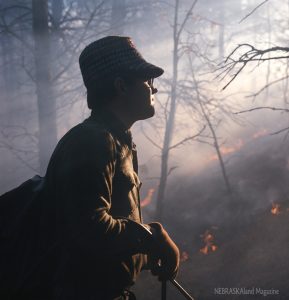
Lon joined the payroll for the agency’s Land Management Division in February and it was not long before the duties would expand beyond fixing and removing fence. Soon, Frank Ehlers, a neighbor of Ponderosa WMA, was hired to assist. Lemmon and Ehlers, under Schlichtemeier’s supervision, became pioneers for wildlife management in the Pine Ridge.
In the June following Lon’s hiring, the Lemmons and their three boys moved from the property’s north cabin into its 980-square-foot single-story ranch house just across Squaw Creek Road. Because the Lemmons lived on-site for 34 of Lon’s 39 years with the agency, it was inevitable that the entire family would be involved in tasks of wildlife and land management.
“They were wonderful years and I’m thankful my family got to share in some of the experiences,” Lon said.
One of Lon’s first orders involving wildlife was something of a “political football,” as he termed it. Game and Parks was asked to assist in removing 100 head of pronghorn from the Sioux Army Depot northwest of Sidney, a nearly 20,000-acre facility that provided ammunition storage from 1942-1967. At the request of the federal government, about 100 head were rounded up by airplane and moved to Kansas.
Future projects would be greeted with more popularity. Lon gives mention to “Mutual of Omaha’s Wild Kingdom,” the popular television show about wildlife that was originally produced 1963-1988, while reflecting on his career.
“We got to do a lot of things that Marlin Perkins would have killed to have done,” he said, in reference to the show’s long-time host.
Lemmon and Ehlers trapped numerous wild animals for research or relocation.
“I have no idea how many hundreds of turkeys that Frank and I caught, then Harvey Suetsugu (a Commission biologist based in Alliance) would take them to other parts of the state for releases,” Lon said.

Some of the first deer monitoring projects in Nebraska were in the Pine Ridge. With a wooden box trap, Lemmon and Ehlers caught deer and placed colored streamers on their ears for future observation. At Ponderosa WMA, for instance, they placed orange streamers on the captures. At a trapping site a little farther east, they used pea green.
“We put the streamers on in January or February,” he said. “In the fall of that year, one of those buck mule deer fawns from the Ponderosa was killed north of Lusk (Wyoming) and one of the bucks wearing a pea green one was killed near Oshkosh.”
Lemmon and Ehlers became experts at designing traps and other tools. They were working on a shoestring budget, especially in the early years before funding from the Habitat Stamp and other sources, and had to make old equipment work or build something that got the job done.
“Frank didn’t have a lot of formal education, but he was an absolute engineer,” Lon said.
Lon and other staff were occasionally called upon to address landowner conflicts with wildlife. On many occasions, for instance, they trapped beavers on private property and relocated them to creeks in the WMAs.
After building corrals and loading chutes at the Wildcat Hills refuge south of Gering in the early 1970s, Lemmon, Schlichtemeier and Ehlers relocated a stock trailer full of captive bison to Fort Robinson State Park – the first bison to inhabit that land since the 1800s. Bison remain a popular feature of the park.
During Lon’s career, many of the parking lots and food plots at area WMAs were established. The water catchment systems designed and constructed during Lon’s tenure, popular with thirsty animals, are still in use at Pine Ridge WMAs and other properties throughout the Panhandle.
Another high-profile project during Lon’s time was the reintroduction of bighorn sheep to the Pine Ridge. While packing in steel posts to fix fence in the northeast part of the ranch the day after his high school graduation in 1955, Lon discovered a massive bighorn sheep ram skull — believed to be from one of the region’s native sheep of the now-extinct Audubon’s subspecies. In following years, he pondered if it would be possible to reintroduce wild sheep to the region. In the summer of 1980 a call from Bill Bailey, the Commission’s assistant director, would put that dream in motion.
“He asked, ‘What do you think it would take to build a fence up over those buttes as an imprint pasture for those sheep?’ I told him it would take some work and some planning, but that it could be done,” Lon said.
Lon began planning with Jim Lemmon, his cousin who was employed at Fort Robinson State Park and would later become its superintendent, to use surplus high woven-wire fence from the fort’s military days and other materials to build an enclosure at the Red Cloud Buttes. The fort had occasionally received labor from inmates from the Nebraska state penitentiary in Lincoln, and seven were assigned to help build the fence.
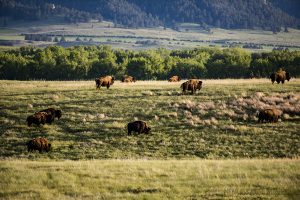
“Some of those were bad boys, but they were glad to get out here and they worked hard,” Lon said.
The fence was successful at holding the sheep, which were relocated from South Dakota in early 1981. Later that decade more than 20 sheep were slowly released to run wild in the buttes and the fence was eventually removed. With the herd growing, Game and Parks initiated a bighorn sheep hunting program and Lemmon, Schlichtemeier and Dean Studnicka, a current Commission biologist who had joined the Ponderosa staff by that time, chaperoned 13 hunts prior to Lon’s retirement.
Lon also gave guidance to graduate students from the University of Nebraska in conducting some of the first elk research projects in the Pine Ridge and pronghorn research in the late 1990s and early 2000s.
“He was a very knowledgeable and valuable local information source for these wildlife students just beginning their wildlife careers,” Schenbeck said.
Perhaps Lon’s proudest habitat accomplishment was the 1,200-acre prescribed burn of Ponderosa WMA in 1998. Schlichtemeier had long wanted to see the burn happen, and after two years of planning by him, Lemmon, Studnicka and other agency staff, the burn was completed without incident and improved the pine forest ecology on the land. It stands as the largest prescribed burn to date in the Pine Ridge.
Much of the work based from Ponderosa WMA through the years had impacts far beyond the Pine Ridge.
At one time, the Ponderosa staff cared for all WMAs in the Panhandle, including the North Platte Valley and the Sandhills from Merriman to Hyannis.
Lon also helped usher in expansions of the Pine Ridge WMAs and the addition of three others — Bighorn, Bordeaux Creek and Chadron Creek Ranch. He worked with families to realize their wishes of making the land public and expresses pride that the WMAs, purchased with funds from sportsmen and sportswomen, have fulfilled the wishes of their previous owners.
The staff also helped clear timber and establish the controlled waterfowl hunting area at Clear Creek Wildlife Management Area near Lewellen. When countless geese and ducks died from fowl cholera in the Rainwater Basin near Holdrege, Ehlers designed and constructed a portable incinerator for removal of the dead birds.
Many in northwest Nebraska know the Lemmons for their longtime personal business, which began after Lon attended auctioneering school in Decatur, Indiana, in 1957. As Lon peddled countless items at farm and ranch sales with an auctioneer’s cadence, Carolyn clerked and handled the bookwork.
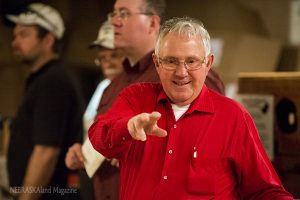
“I liked the auction business, but I loved the wildlife,” Lon said. “Carolyn kept the auction business going. We wouldn’t have had an auction business if it wasn’t for Carolyn.”
Often, Lon and Carolyn have blended auctioneering with their love for wild animals. Although retired, they still donate their auctioneering services at banquets for conservation organizations such as the Rocky Mountain Elk Foundation and National Wild Turkey Federation. They both serve on the banquet committee for the Pine Ridge chapter of RMEF.
Among the most rewarding facets of his career has been meeting so many people, Lemmon said. Schenbeck noted in the award nomination that Lon and Carolyn set a high bar with their people skills and were unmatched at presenting the sincere “human side” of Game and Parks.
The Lemmons live on a small acreage just a couple miles up the road from the Ponderosa WMA, and Lon, 79, often stops by the old house, which now serves as an office building. The Commission’s young biologists enjoy gleaning information from the wildlife management veteran and hunters enjoy reliving “the good old days.”
“I’ve met so many people through the years from all over the United States,” Lon said. “A lot of the hunters I got to know still stop by to say hi or send Christmas cards. We always love to hear from them.”
For not seeking a life in wildlife management, the Lemmons have certainly made the most of it.
 Nebraskaland Magazine
Nebraskaland Magazine
